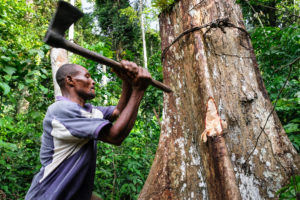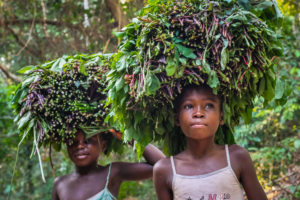The growing charcoal business in sub-Saharan Africa has often been seen as a male-dominated occupation, with few studies exploring gender dynamics. In reality, women are present throughout the value chain –from production to transport, sale and retail— and their involvement plays a vital role in sustaining rural livelihoods, especially in times of duress.
Gendered barriers not only hinder equal participation and benefits in the sector, but they can also undermine the efficiency and environmental sustainability of the value chain as a whole. As the charcoal business expands to cater to the continent’s growing population, it is ever more important that policies identify and address these barriers in each of the countries.
Scientists at the Center for International Forestry Research (CIFOR) and World Agroforestry (ICRAF) have recently come up with a framework for incorporating gender analysis in future research and policy-making in the charcoal sector.
Following an extensive review of existing studies, researchers also produced a snapshot of available information on gender and charcoal value chains, and identified knowledge gaps for future research.
Participation is not enough
The review process made clear that sex-disaggregated data on the charcoal value chain is patchy and often limited to field observations. Even when sex-disaggregated data on participation or benefits is available, few studies conduct gender analysis to make sense of the observed differences.
However, by examining selected papers, the review found that women participate throughout the value chain, although they concentrate in retail, and that female producers tend to get involved as a last resort. Hence, obstacles to women’s participation and benefits may have a disproportionate welfare impact, especially given the high numbers of female heads-of household among producers.
Yet, having more women participate in the charcoal sector does not necessarily indicate greater gender equality.
The engagement of women and men in the charcoal sector, and what they get out of it, are heavily influenced by gender differences and inequalities, which in turn often intersect with other aspects such as wealth and social class, marital status and age. Notable differences are found, particularly in access to and control over productive resources and income; social and political capital and gender roles and responsibilities.
For instance, studies suggest that women tend to produce less charcoal than their male counterparts, often due to a lack of access to tools, information and labor. Where producers’ groups channel licenses and capacity building, underrepresentation of small female producers can aggravate the disparity.
Similarly, female transporters usually ferry fewer bags per trip due to difficulties in accessing transport vehicles, while unequal access to finances can limit the ability of female retailers to store and bulk.
These observations illustrate how gender inequalities can constrain women’s abilities to earn more money through increasing production, selling higher volumes and accessing better markets.
Differences in financial and political power also put women at a disadvantage in both the informal and the formal charcoal sector. Inequalities limiting women’s access to information and tools, household finances, political connections and mobility, for example, can make it particularly difficult for female producers and retailers to comply with national charcoal regulations.
Although not always the case, poverty and inequalities have often been seen to push women into the charcoal sector, reinforcing the notion that greater female engagement is not a positive sign in itself.
The environmental impact of charcoal production offers a paradigmatic example.
Some studies note its effects are disproportionately borne by women because deforestation and forest degradation reduce their ability to generate income from firewood and other non-timber products.
As charcoal production erodes women’s alternative income sources, more of them may be forced to join the charcoal sector. In time, trees become scarce and production sites are moved further away from villages. This might further complicate things for women where it is not socially acceptable for them to work away from their homes and families.
In addition, gender inequalities may impact the sustainability of the value chain. A study in Cameroon, for example, found that women’s harvesting practices had a higher environmental impact compared to their male counterparts. This was attributed to women’s use of more rudimentary tools, which led them to cut smaller, younger tree stems close to their homes.
Addressing unanswered questions
Gender issues affect who participates in, and benefits from, each of the steps of charcoal value chain, and they also influence the efficiency and sustainability of a sector impacting the livelihoods of millions of people in sub-Saharan Africa.
To advance the understanding of gender dynamics in the charcoal sector, there is a need for systematic and robust sex-disaggregated data on participation; more studies on gender dynamics along downstream nodes, which tend to have higher proportions of women; and a deliberate focus on the ways in which gender norms and relations influence and are influenced by factors such as institutional and governance arrangements or the social and environmental impact.
The study conducted by CIFOR and ICRAF proposes a conceptual framework to guide future research on these various issues, informing better policies and combating women’s marginalization. It encourages analysis from various perspectives, ranging from the decision-making power in the household to community-level institutions and norms as well as legal systems.
The conceptual framework explores how gender roles and relations, in combination with factors such as age, class and ethnicity, influence women and men’s motivations to participate in the charcoal sector, as well as the costs and benefits associated with their involvement.
It also intends to show how gender differences and inequalities in the value chain influence its structure, efficiency and sustainability, and the impact of broader gendered norms and relations in the nature and extend of women and men’s participation.
Importantly, the available evidence shows the need to place gender analysis at the core of charcoal value chain studies and interventions, rather than approaching it as an add-on component that is haphazardly conducted in the periphery of project activities.
The charcoal sector is expanding as an affordable energy source for the growing population of the continent, and it provides people in rural and peri-urban settings with much-needed income.
This study distills the current understanding on gender and charcoal value chains, and provides guidance to address the numerous, and important, questions that remain unanswered. Questions that shall inform better charcoal-sector policies and interventions for the benefit of people and the environment across the continent.
By Markus Ihalainen, FTA Gender Specialist.
This article was originally published on Forest News. FTA is the world’s largest research for development program to enhance the role of forests, trees and agroforestry in sustainable development and food security and to address climate change. CIFOR leads FTA in partnership with Bioversity International, CATIE, CIRAD, INBAR, ICRAF and TBI. FTA’s work is supported by the CGIAR Trust Fund.













